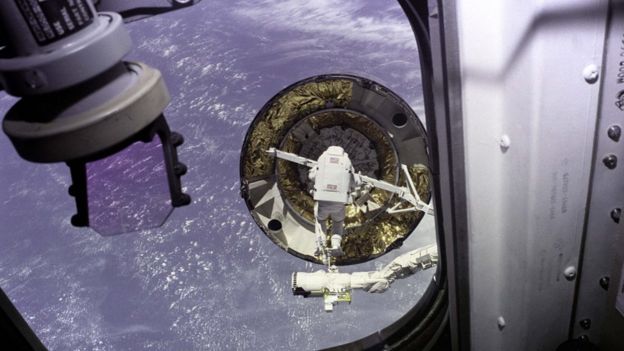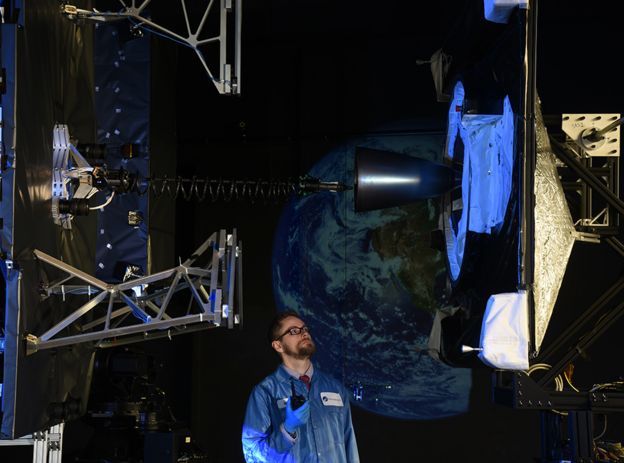27.02.2020


Two American satellites have docked high over the Atlantic in a demonstration of what many commentators expect to be a burgeoning new industry.
One of the platforms is an old telecoms spacecraft low on fuel; the other is an auxiliary unit that will now take over all the former's manoeuvring functions.
This will allow Intelsat-901 to extend its 19-year mission of relaying TV and other services by another five years.
The event has been described as a major accomplishment by the firms involved.
Northrop Grumman, which produced the Mission Extension Vehicle-1 that grabbed hold of Intelsat-901, said it was the first time two commercial satellites had come together in this way at an altitude of just over 36,000km.

MEV-1 will now push IS-901 to an equatorial position at 27.5 degrees West so it can resume telecoms duties in late March or early April.
The satellite industry has been talking for some time about a capability to carry out in-orbit servicing and re-fuelling of ageing spacecraft, and even to bring defunct assets out of the sky altogether. But the Northrop Grumman/Intelsat arrangement is really the first commercial initiative to bear fruit.
The docking occurred on Tuesday at 02:15 EDT (07:15 GMT), approximately 300km above the geosynchronous arc from where most telecoms satellites relay their data.


This permitted MEV-1 to approach IS-901 with the confidence that if anything went wrong during the rendezvous procedure, no nearby operational spacecraft would be compromised.
The docking was autonomous. The MEV-1 achieved this by driving a probe into the IS-901's engine nozzle and then opening some "fingers" to lock the two spacecraft together.
This animation shows how the MEV-1 approach and docking would have worked

Northrop Grumman's vehicle will now control all movement for the pair, including the precise pointing required by IS-901 to map its telecommunication beams on to the right regions of Earth's surface.
When the Intelsat's extended mission comes to an end, the MEV-1 will take the telecoms platform to a "graveyard" orbit before then joining up with another "running on empty" customer that needs the same manoeuvring assistance.
Northrop Grumman, which is operating its new servicing business through a subsidiary, SpaceLogistics LLC, said it planned to expand the basic "tug" concept offered by MEV-1 to include vehicles capable of in-orbit repair and assembly.
Already it is working on systems that would feature not just simple docking probes but robotic arms to grab hold of satellites. Another option being developed is fuel pods that can be attached to satellites running low on fuel.
 Image copyrightNASA
Image copyrightNASA
Tom Wilson, a vice president with Northrop Grumman Space Systems and president of SpaceLogistics LLC, said he also foresaw applications for the US space agency when it sent astronauts far beyond Earth.
"As Nasa goes beyond [the Moon] all the way out to Mars and explores the Solar System, there's going to be the need to do all kinds of autonomous robotic missions - the ability to join vehicles together, to do rendezvous proximity operations, the ability to manufacture pieces or components that you didn't know you needed. All this technology leads to those types of vehicles and services," he told reporters.
Northrop Grumman/SpaceLogistics LLC is scheduled to launch a second MEV later this year. This is contracted to provide support to a different Intelsat satellite.
Intelsat CEO Stephen Spengler said his company had long supported the concept of in-orbit servicing, and he recalled the space shuttle mission in 1992 that famously rescued Intelsat-603 which had become stranded in low-Earth orbit.
"We push the boundaries of what's possible and turn those possibilities into reality. That is why we have been a fervent supporter of space servicing for many years now," he said.
"The economics work for us and it makes sense. It allows us to extend revenues and allows us to defer capital expenditures until a little bit into the future."
 Image copyrightNORTHROP GRUMMAN
Image copyrightNORTHROP GRUMMAN
Quelle: BBC
